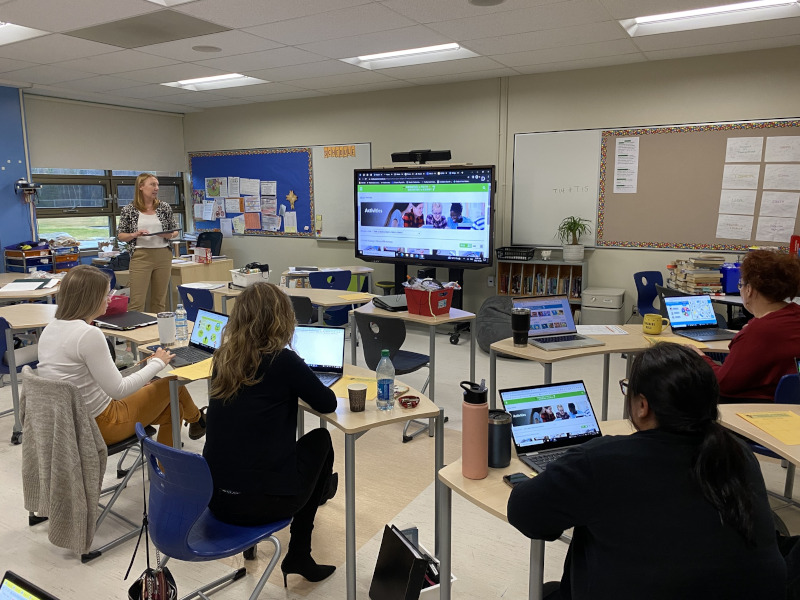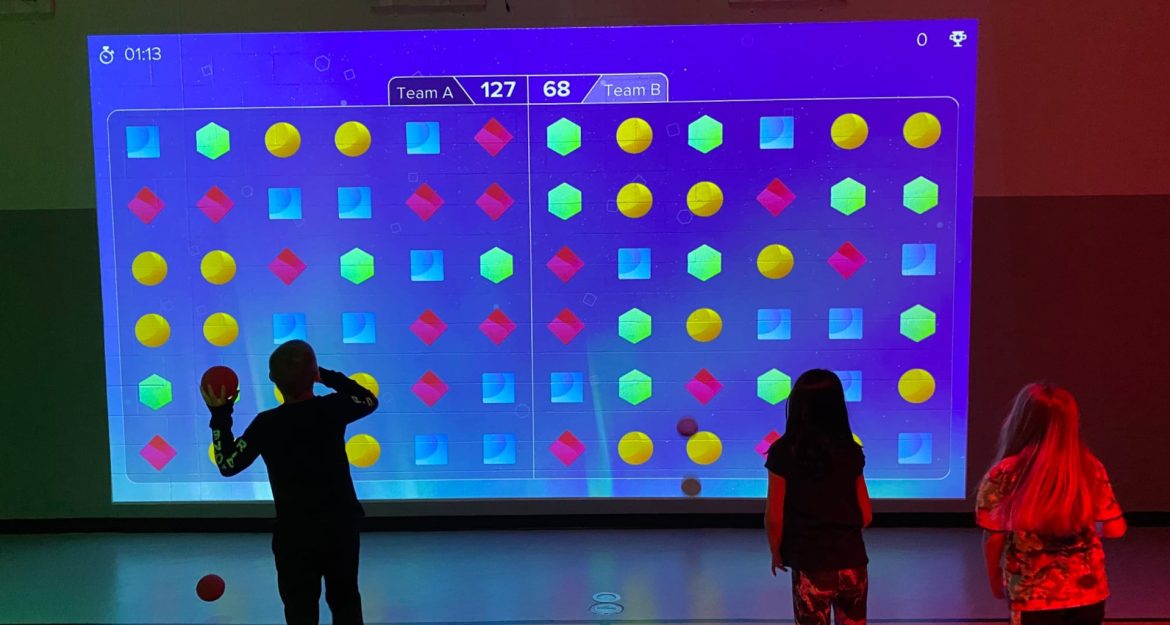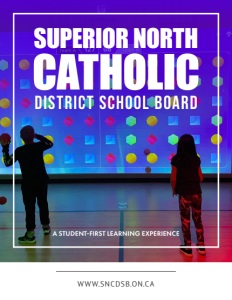Superior North Catholic District School Board
A Student-First Learning Experience
Educating Heart, Mind, and Soul
Located in the remote northern region of Ontario, the Superior North Catholic District School Board spans over 14,000 square kilometers but is one of the smallest boards in the province, encompassing nine physical schools with approximately 720 students from kindergarten to grade 8.
Encapsulating the board’s ethos, Maria Vasanelli, Director of Education states, “Our core values are to inspire spiritual growth within an inclusive and respectful environment and to graduate students who have the knowledge, skills, and competence to affect change.” Meaningful education transforms and we keep that thought at the forefront.
“Our mission statement says it all, ‘Together, We Educate Heart, Mind, and Soul.” Along with this, Assistant Superintendent, Christopher Martin, asserts, “We have to keep equity at the forefront, making sure that we’re providing opportunities for all of our students to be successful in anything that they want to try and do.”
Student-Centered and Teacher Supported
At the heart of the district’s teaching philosophy is a student-centered approach. “That starts with the relationship that our educators have with the students and with their families. It’s about knowing our students deeply, in an ongoing way, to make sure that we’re providing the support, the materials, the expertise, to make sure that we can move every student from their point A to their individual point B,” Martin depicts.
He underscores the significance of what the board terms, ‘Teaching Excellence’, which is outlined in their strategic plan. Professional development for teachers is a priority, and Superior North Catholic District School Board supports ongoing learning, encouraging educators to engage in both board-provided and self-guided professional development. “We want to make sure that we have very well-rounded and professional teachers and educators in front of our students,” he remarks. Vasanelli believes that life-long learning is essential not just for teachers but all who work in the system, including superintendents and managers.
Infrastructure and Safety
Barry Biggs, Plant and Field Services Manager, emphasizes the board’s focus on creating optimal learning environments by directing funding to areas of priority. Over recent years, significant investments have been made in safety infrastructure, as well as improvements to interior and exterior functions and aesthetics.
“During COVID, we enhanced all of our internal fresh air ventilation throughout all of our schools,” he reports. “We’ve also provided UV lights through all of our air handling equipment in all of our schools. We’re taking care of killing any pathogens to a 99% effective rate.”
The board has also improved outdoor play areas, adding artificial turf and foam, ensuring students have safe, year-round access to physical activity. Biggs explains, “In the north grass doesn’t grow as well as it does in the south, and to be able to have enhanced facilities for the kids to play in is important for us. In the springtime, they are the first areas that melt, which allows the students to go outside and be active.”
These efforts are part of a comprehensive five-year infrastructure plan, funded through government grants and additional funding sources. The plan not only addresses immediate improvements but also ensures the longevity and sustainability of school facilities.
Laying a Strong Foundation
Vasanelli emphasizes the importance of early learning,” We concentrate on prevention and early screening,” she says. We want to make sure that we spend a lot of time on programming for those early grades because they are critical.” She adds that the board’s curriculum incorporates land-based and experiential learning, “We have over 50% Indigenous students, and our curriculum has to reflect their experiences.”
Martin further spotlights the value of developing relationships with families and community partners like local daycares and First Nations communities. “We know that if we’re having conversations with them, getting to know their children in an ongoing way, we can better meet those students’ needs when it’s time for them to come to our schools,” he conveys. “We do provide opportunities for the daycares to come and visit our school sites and to participate with our kindergarten learning teams. It’s a great way for families to get used to the school environment, to get used to the educators, and for the students to get used to our facilities.”
Technology, STEAM, and Student Development
Vasanelli shares that every student has access to the latest technology, including Chromebooks, 3D printers, and virtual reality tools. “Our board is a leader in using technology as a tool for teaching and learning,” she acknowledges. “One of our Strategic Plan pillars is ‘Focus on the Future’. That means that we need to prepare children for jobs that don’t even exist yet. So those things, as well as critical thinking skills, are key for us in preparing our students.” Regarding STEM initiatives, Martin conveys, ” We’ll go one step further and involve the Arts to make STEAM. When we’re talking about meeting the needs of each of our students, valuing that student voice is extremely important to us. And the arts very much came through on our most recent student surveys.”
In addition, students participate in initiatives such as the United Nations Sustainable Development Goals challenge, encouraging creative solutions to complex global issues. Superior North Catholic also encourages the development of vital skills such as responsibility, collaboration, and empathy, preparing students to succeed in today’s team-oriented environments.
Community Partnerships
When it comes to partnerships, Biggs stresses the importance of local contractors like Thermal Mechanical from Thunder Bay, who ensure reliable HVAC and heating services across the vast district. “In the north that’s incredibly important, to have that security of having someone to be able to come to our site when we do have issues,” he asserts. “We’ve got a solid base of contractors that know our schools. They know where we’re located, and they serve us to do the work that we need to do. We’ve been very fortunate in that.”
The creation of a nature trail at Holy Savior School, in partnership with the town of Marathon, showcases the district’s commitment to the community. As well, Superior North Catholic welcomes student teachers from Lakehead University. “We have an excellent partnership with them, and also with Confederation College, who have also helped us construct programs for our educational assistants for continuous learning,” Vasanelli relays.
Martin says collaboration with local entities is key to the district’s success, “We can’t do the great things at Superior North Catholic without some very key partnerships,” he maintains. These include local parishes, and First Nations Communities. As community hubs, Superior North Catholic welcomes community use of schools, inviting nonprofit groups to use their facilities. Students also volunteer at long-term care homes and hospitals.
“Yes, we’re an academic organization and academics are extremely important to us,” depicts Martin. “But it’s also important that our students know how to be responsible citizens when they leave our doors. The future of our small communities depends upon that piece.”

A Vision for the Future
The Superior North Catholic District School Board is committed to an inclusive approach that focuses on the safety, well-being, and holistic development of its students. Looking ahead, Martin says, “One of the pillars of our strategic plan is ‘Focus on the Future’. So, that is something that we keep at the forefront all the time. It’s important to have that mindset when we’re coming up with programming, so we can continue to use our funds sustainably and effectively.”
Biggs says his goals in the coming years include the completion of a $2.8 million addition and renovation of St. Hilary School in Red Rock, which encompasses the introduction of a Native Studies and Learning classroom, sensory space, and a designated French learning area.
He also anticipates a continued focus on energy conservation initiatives, noting, “In the next year, we hope to have a small solar project at one of our schools to show students what can be had by doing this. It’ll not only help our energy costs, but it’ll be a good learning tool.”
Expanding breakfast programs to ensure no student starts the day hungry is also top of mind.
For Vasanelli, the growth of secondary school credits, completion of infrastructure projects, and the well-being of students and staff are all top priorities. Managing a system that puts people over everything else is key to effective decision-making. She points out, “Our main value is our students. We want caring teachers and staff who will help our kids develop into good, caring individuals, especially at a time when we see so many things going on in the world that are not okay. We’re just trying to make sure that our graduates turn out to care and act.”
AT A GLANCE
Superior North Catholic District School Board
What: An innovative rural school board
Where: Northern Ontario, Canada
Website: www.sndsb.on.ca





